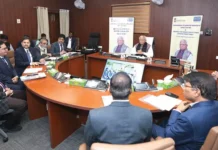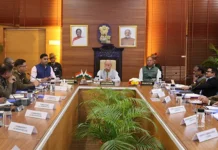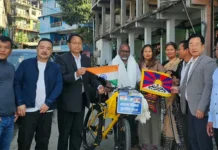[ Marli Kamki ]
Fires are accidents which occur most frequently, whose causes are diverse, and which require intervention methods and techniques adapted to the conditions and the needs of each incident.
Fire accidents have been recurring time and again in various parts of the state. According to the data released by the National Crime Records Bureau, the country witnessed 59 deaths due to fire incidents per day between 2001 and 2014. These accidents are leading not only to loss of properties but also of precious human lives.
With most of the villages still using locally available resources like bamboo, toko-patta (Livistona jenkinsiana griff), etc, for constructing houses and other structures, the danger is imminent at all times. The government has over the years provided CGI sheets and grants for construction of pucca houses under various schemes and yojanas. But even if one takes up modern construction ways, the threat is still there as the cause of occurrence may vary at all times.
There is growing demand for establishment of fire stations in many administrative headquarters and blocks. With massive shortage of manpower and fire tenders, resource-crunched states like ours have to think out of the box and resort to innovative practices to mitigate this ever looming crisis. There are places like Kamba in West Siang district where, by the time a fire tender reaches from district headquarters Aalo, everything is reduced to ashes.
While on a recent visit to Kamki village in West Siang district, yours truly came cross a unique practice of the Galo community. Traditionally called ‘Langka pal’, this practice has been carried on since time immemorial by the members of the Galo community to avert mishaps and fire accidents.
Traditionally, Langka pals are fire guards whose duty is to make rounds of the village at all times, from sunrise to sunset. He/she has to alert the villagers in case of any fire accident. The duties are allotted to the households on a rotation basis, following a collective decision of the lune bane (society).
In the olden days, usually most of the villagers would be away working in the fields, leaving only the langka pals, comprising a minimum of two members, to guard the village until their return after the sun had set. The langka pals would also be tasked with the duty of watchdogs against any possible theft in the village.
The modus operandi adopted was very simple. They had to move around each and every house to notice any smoke. If any smoke was found issuing from a house, the langka pal had to call out for the owner. In case there was no response, the langka pal had the right to enter the house to douse the smoke/fire even if he was on arii (locally restricted to do or eat anything). Those on duty as langka pals originally had to carry a dao (machete), hotam (a type of shield locally made of bamboo), banggiii (cane stick), and nibu (almost round in shape and half metal).
Basically, the sole responsibility for saving the village from any fire mishap lay on the langka pals. In case there was any negligence of duty on their part, they were liable for punishment by the lune bane.
Information gathered revealed that Kamki village has recorded very few fire-related accidents, except a couple which were suspected to be manmade. The age-old system of appointing langka pals was prevalent in almost all the Galo villages, but with the advent of modernity and other factors, many villages have discontinued it.
The entire state is facing the menace of fire accidents. Such incidents have serious effects mostly on the poor and the lower-income groups who take a very long time to recover from such accidents. Some do not recover at all.
The state government should give a serious thought to reviving and adopting the langka pal/fire guard system as practiced by the members of the Galo community. Any of the villages still practicing this system can be adopted on a trial basis.
Someone has rightly said, ‘India lives in its villages.’ This cost-effective model has stood the test of time in the villages, and it can also be a source of employment generation for the local village youths. (The writer is secretary, debate and symposium, AAPSU)





